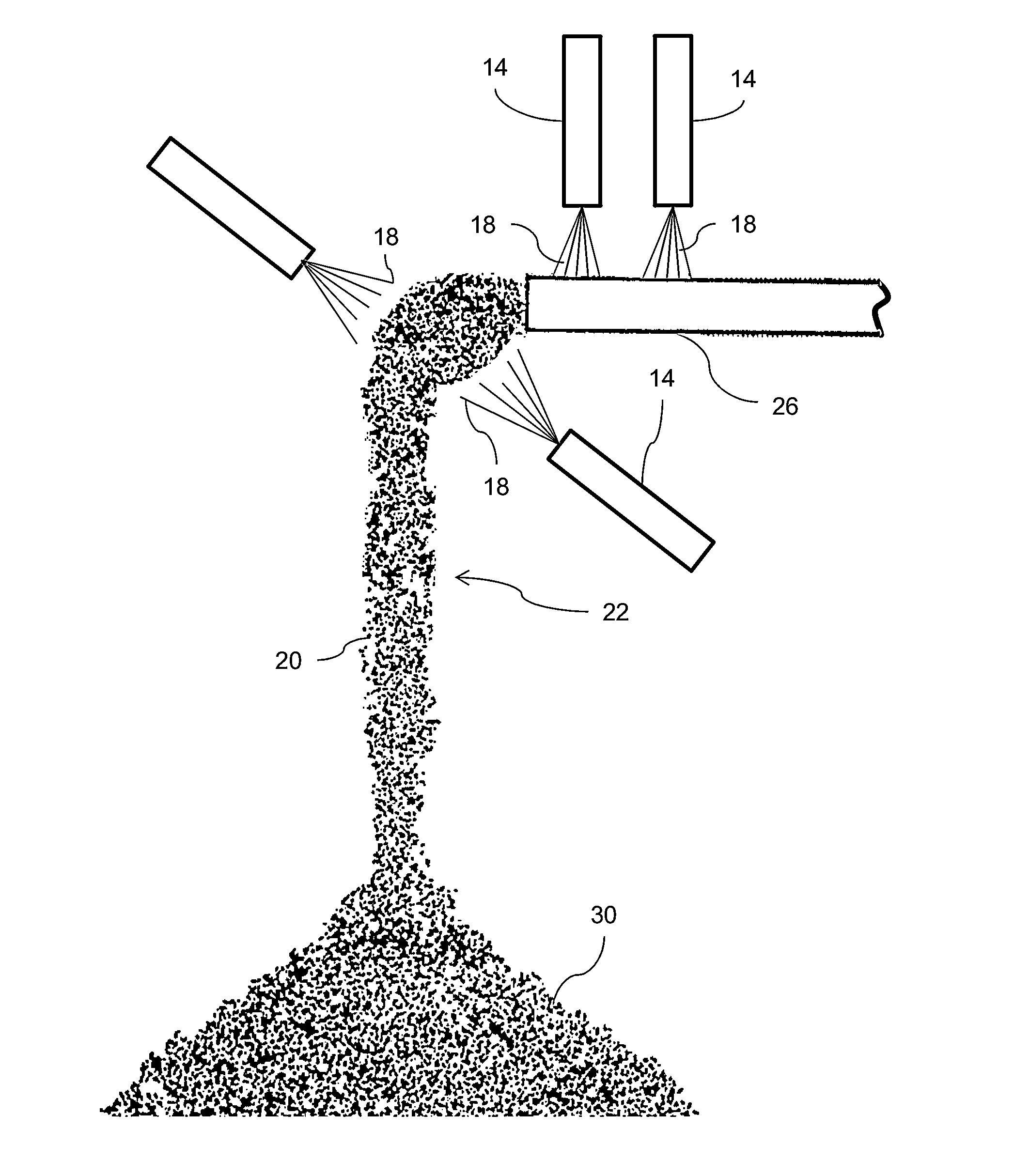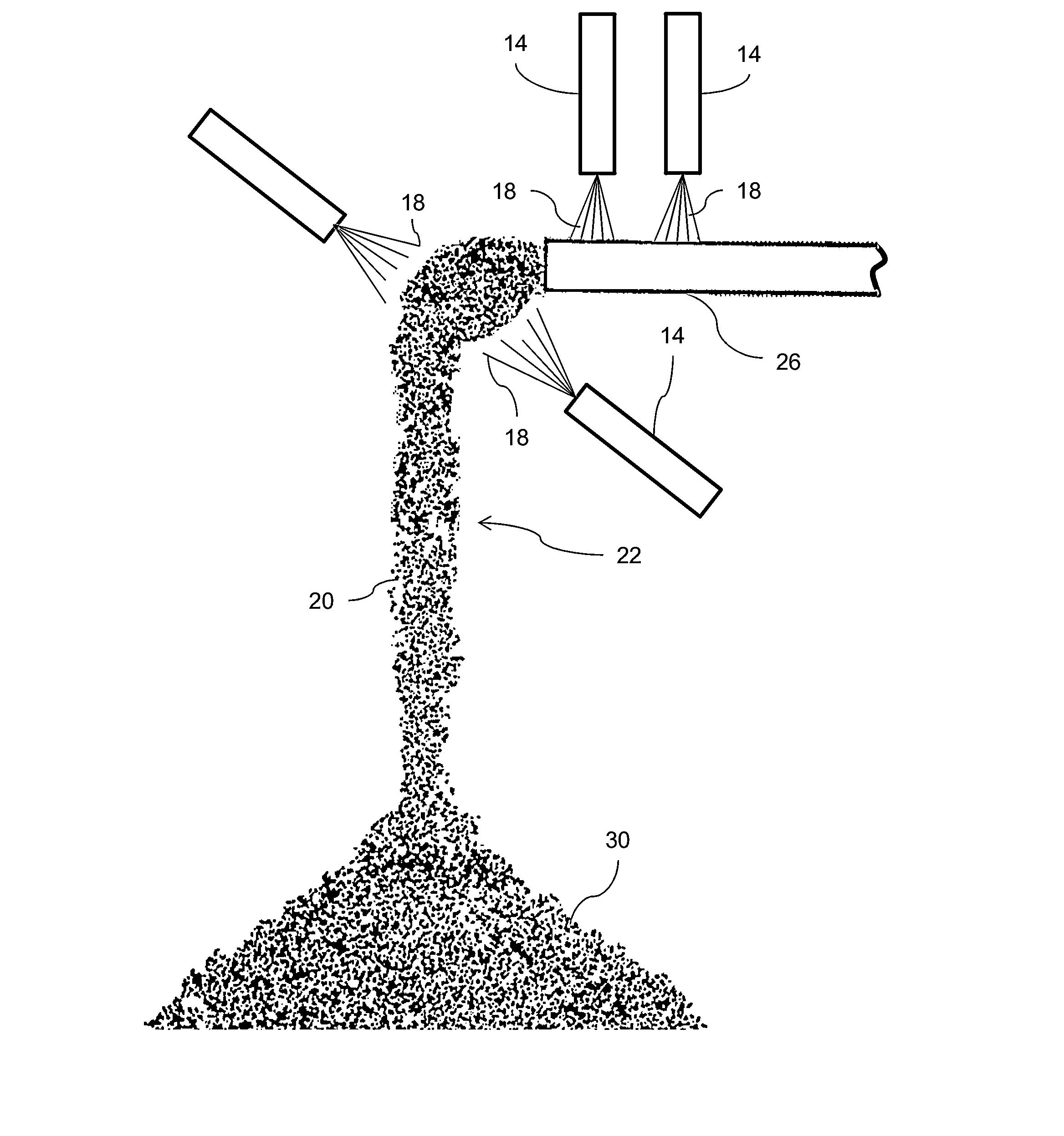Dust suppression formulas using plasticized cellulose ethers
a technology of cellulose ether and dust suppression formula, which is applied in the field of dust suppression formulas using plasticized cellulose ethers, can solve the problems of long-known health hazards and economic losses of dust generation during material transportation and handling, and achieve the effect of reducing or eliminating the ability of dusting materials
- Summary
- Abstract
- Description
- Claims
- Application Information
AI Technical Summary
Benefits of technology
Problems solved by technology
Method used
Image
Examples
example 1
Measurement of Strength for Plasticized and Non-Plasticized Cellulose Ether Formulations
[0033]To a sample of damp 18 mesh to 60 mesh (1 mm-0.25 mm) sub-bituminous coal was added a solution of 1.5 wt. % 400 cPs hydroxypropyl methylcellulose (HPMC). The solutions contained 1.0 wt. % commercial coal wetting solution concentrate (BT-205W supplied by Benetech, Inc.). The solution also contained plasticizers of the indicated composition. The amount added was such that the total mass of the sample was comprised of 20 wt. % or 25 wt. % of the solution with the remaining 80 wt. % or 75 wt. % coal. The samples were mixed and pressed into 30 mm diameter round plastic forms with a depth of 15 mm. The samples were heated to 40° C. overnight and in the morning cooled and broken using a force gauge. The maximum force required (in milliNewtons) to break the sample was divided by the mass of the sample (in grams) to give a specific strength that was independent of the mass of the sample. Results are...
example 2
Examination of the Effect of Cellulose Ether Chemistry on the Strength of Coal-Dust Binding
[0036]To a sample of 18 mesh to 60 mesh (1 mm-0.25 mm) sub-bituminous coal was added a solution of 1.5 wt. % of various cellulose ethers. The cellulose ethers were produced by Dow and their chemistry and nomenclature are discussed in the previously cited “Methocel Cellulose Ethers Technical Handbook” available from Dow's web site. All cellulose ethers were of the same viscosity grade: 4,000 cPs at a 2.5 wt. % solution. The chemistries ranged from “A” chemistry which was pure methylcellulose, through “E”, “F”, “J”, and “K” chemistries. Of the hydroxypropyl-substituted cellulose ether chemistries it is worth noting that “F” chemistry has the least amount of hydroxypropyl substitution. The solutions contained approximately 22 wt. % commercial coal wetting solution concentrate (BT-205W supplied by Benetech, Inc.). The amount added was such that the total mass of the sample was comprised of 25 wt. ...
example 3
Measurement of Strength for Plasticized and Non-Plasticized Sodium Carboxymethylcellulose Ether Formulations
[0039]To a sample of dry fresh-ground 18 mesh to 60 mesh (1 mm-0.25 mm) sub-bituminous coal was added a solution of 4.0 wt. % sodium Carboxymethylcellulose (supplied by Ashland Chemical, Aqualon Division, type 7L). The solutions contained 0.5 wt. % commercial coal wetting solution concentrate (BT-210WF supplied by Benetech, Inc.). The solution also contained plasticizers of the indicated composition. The amount added was such that the total mass of the sample comprised 25 wt. % of the solution with the remaining 75 wt. % coal. The samples were mixed and pressed into 30 mm diameter round plastic forms with a depth of 15 mm. The samples were heated to 41° C. overnight and in the morning cooled and broken using a force gauge. The maximum force required (in Newtons) to break the sample was divided by the mass of the sample (in grams) to give a specific strength that was independen...
PUM
| Property | Measurement | Unit |
|---|---|---|
| temperatures | aaaaa | aaaaa |
| diameter | aaaaa | aaaaa |
| diameter | aaaaa | aaaaa |
Abstract
Description
Claims
Application Information
 Login to View More
Login to View More - R&D
- Intellectual Property
- Life Sciences
- Materials
- Tech Scout
- Unparalleled Data Quality
- Higher Quality Content
- 60% Fewer Hallucinations
Browse by: Latest US Patents, China's latest patents, Technical Efficacy Thesaurus, Application Domain, Technology Topic, Popular Technical Reports.
© 2025 PatSnap. All rights reserved.Legal|Privacy policy|Modern Slavery Act Transparency Statement|Sitemap|About US| Contact US: help@patsnap.com


